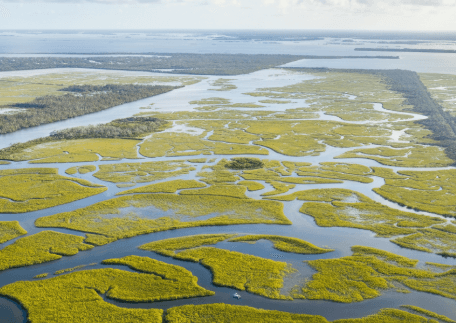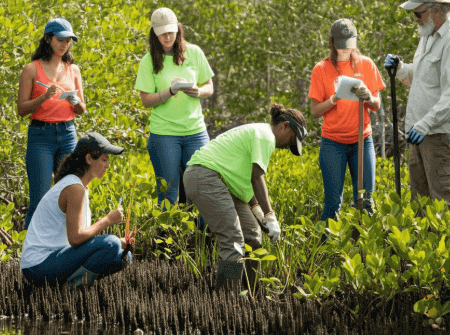Florida’s landscape is adorned with a mesmerizing variety of ecosystems, among which wetlands hold a significant place. In this blog, we aim to explore the different types of wetlands that grace Florida land, offering a sanctuary to diverse wildlife and acting as natural water filtration systems. Understanding the different types of wetlands is crucial for appreciating their ecological importance and the hurdles they encounter because of environmental shifts and human interference. Join us as we take a closer look at the unique characteristics and vital functions of the different types of wetlands in Florida, highlighting their role in the ecosystem and their impact on the natural beauty and biodiversity of the region.
Real estate investors Steve Daria and Joleigh have shown a keen interest in developing sustainable properties adjacent to Florida’s wetlands, recognizing the critical balance between development and conservation. Their efforts contribute to protecting these vital ecosystems while promoting eco-friendly living solutions.
Navigating the Different Types of Wetlands
Thanks to its geography and climate, Florida, which covers 30 percent of the state, harbors a diversity of wetland habitats.
This vast expanse of wetlands includes marshes, swamps, bogs, and more, and their ecological services are as varied as their terrains.
Every wetland, whether seasonal or permanent, freshwater or saltwater, plays a fundamental role in flood control, water filtration, and as a sanctuary for many plant and animal species.

The state’s wetlands are not only a haven for wildlife but also a mecca for adventure seekers and a crucial asset in mitigating the impacts of climate change.
The Marshlands – Nursery of the Everglades
Florida’s marshlands, characterized by their expansive reed-filled areas and shallow waters, are crucial ecosystems often called the “kidneys of the Earth” due to their unparalleled ability to purify water.
These marshlands, including iconic regions like the Everglades, are fundamental in maintaining the region’s ecological balance.
Stretching across vast tracts of land, Florida’s marshlands act as natural filtration systems, effectively cleansing water through their intricate network of channels and marshy areas.
One critical function of Florida’s marshlands is preventing ponding, particularly during periods of heavy rainfall or storm events.
By absorbing and storing excess water, marshlands help mitigate flooding in surrounding areas, acting as natural sponges that regulate water levels and reduce the risk of inundation.
Cypress Swamps – The Ghostly Guardians of Wetlands
Standing stoically in waters sometimes tinged with tannic acid, the swamps’ cypress trees provide eerie beauty and critical structural support to the wetland ecosystem.
Their sprawling root systems help prevent soil erosion, maintain water quality, and provide habitat to countless organisms.
Coastal Wetlands – Brackish Harmonies
Coastal wetlands, exemplified by the intricate ecosystems of mangrove forests, represent a dynamic interface between terrestrial and marine environments. The interplay of salt and fresh water fosters unique ecological processes.
Mangrove forests, with their labyrinthine roots and resilient foliage, demonstrate an extraordinary adaptability to fluctuating water salinity levels, thriving in the challenging conditions of coastal regions.
These coastal wetlands serve as vital protective barriers, shielding inland areas from the destructive forces of storm surges and coastal erosion.
The dense network of mangrove roots stabilizes shorelines and absorbs and dissipates wave energy, reducing storms’ impact on adjacent communities and infrastructure.
Get Started: Get Your Cash Offer Below…
We are direct land buyers. There are no commissions or fees and no obligation whatsoever. Start below by sharing where your property is and where we can send your offer…
Wetland Buyers Guide: Deciphering the Market
Understanding the nuances of different types of wetlands is pivotal for the savvy investor or prospective land buyer.
The kind of wetland it encompasses is just the beginning when assessing the value of wetland properties.
The Economic Pillars of Wetland Types
Certain wetland types, such as bogs with their rich peat deposits, hold the potential for eco-friendly resource extraction.
At the same time, the sheer beauty and conservation value of certain estuarine wetlands can command premium prices in the market.
Navigating Regulations
Given their ecological sensitivity, wetlands are often subject to stringent regulatory oversights.
Familiarity with the legal landscape, particularly the jurisdiction of firms such as the Environmental Protection Agency and the U.S. Army Corps of Engineers, is indispensable for any wetland transaction.
Valuation Parameters
Wetland valuation goes beyond the traditional parameters of land assessment.
Factors unique to wetland properties, like their carbon sequestration capacity and role in supporting tourism, must be integrated into a comprehensive valuation model to reflect their true worth.
Wetlands in Harmony: Conservation and Development
An age-old debate rages on – how to balance conserving wetlands and catering to the land’s developmental needs.
The answer is a harmonious approach that values different types of wetlands equally for their ability to support growth and their intrinsic worth.
Mitigating Wetland Loss
With Florida experiencing one of the nation’s highest rates of wetland loss, mitigation banks have emerged as a potent tool.
Investors can purchase wetland “credits” generated by restoring or creating wetlands, thus offsetting the adverse impact of development elsewhere.
Smart Development Practices
The concept of “smart growth” is gaining traction. It emphasizes preserving crucial natural resources like wetlands while accommodating developmental requirements.
Leveraging compact, mixed-use developments and enhancing existing infrastructure can assist in mitigating sprawl into these delicate ecosystems.

Public-Private Partnerships
Collaborative efforts between government entities, private organizations, and individuals are proving effective in managing and conserving wetlands.
Such partnerships can lead to innovative conservation strategies that address ecological imperatives and economic drivers.
Weathering the Storms: Wetlands and Resilient Communities
Florida’s many wetlands are a frontline defense against the destructive forces of hurricanes and sea-level rise.
They provide a buffer and capture and store large volumes of water, helping manage floods, an increasingly common feature of the state’s landscape.
Coastal Wetlands’ Role in Storm Protection
The protective services rendered by Florida’s coastal wetlands are a shield for both natural and human communities.
Enhancing and preserving these wetlands is critical for building resilient communities that can withstand the wrath of nature’s most potent storm systems.
The Future of Wetland Management
Adjusting to the challenges of a changing climate necessitates a paradigm shift in wetland management.
Encouraging sustainable land use practices, investing in green infrastructure, and reimagining development in flood-prone areas are parts of the evolving strategy to ensure the long-term health and relevance of wetlands.
Conclusion
Fathom-deep in Florida’s myriad wetlands is a legacy that spans generations—of rugged beauty, ecological bounty, and the abiding need for stewardship. By acquainting ourselves with the different types of wetlands and their stories, we can cultivate a deeper appreciation for these complex ecosystems and their critical role in our lives.
Ultimately, the tapestry of Florida’s wetlands is more than a marvel of biodiversity; it’s a source of resilience and a testament to the power of nature. Whether navigating these lands for leisure, profit, or the common good, our collective understanding and protection of these vital resources will determine the richness of the legacy we leave for the future.
**NOTICE: Please note that the content presented in this post is intended solely for informational and educational purposes. It should not be construed as legal or financial advice or relied upon as a replacement for consultation with a qualified attorney or CPA. For specific guidance on legal or financial matters, readers are encouraged to seek professional assistance from an attorney, CPA, or other appropriate professional regarding the subject matter.
